

To start our trip, I flew with my parents from Baltimore out to Rapid City, South Dakota. My parents were flying on free tickets after Delta horribly screwed up a trip that they had taken to Ireland the previous year, with disastrously bad plane troubles delaying their arrival overseas by a full day. No such problems manifested on this trip and we arrived on time in South Dakota. The Rapid City airport was one of the smallest that I've flown through, a tiny little regional affair that likely would have been smaller yet if it wasn't for the nearby presence of Mount Rushmore. Rapid City itself isn't a particularly large metropolitan area, with a little over 70,000 residents at the time of our visit. We didn't spend much time in Rapid City itself on this trip, instead securing our rental car and heading onwards.

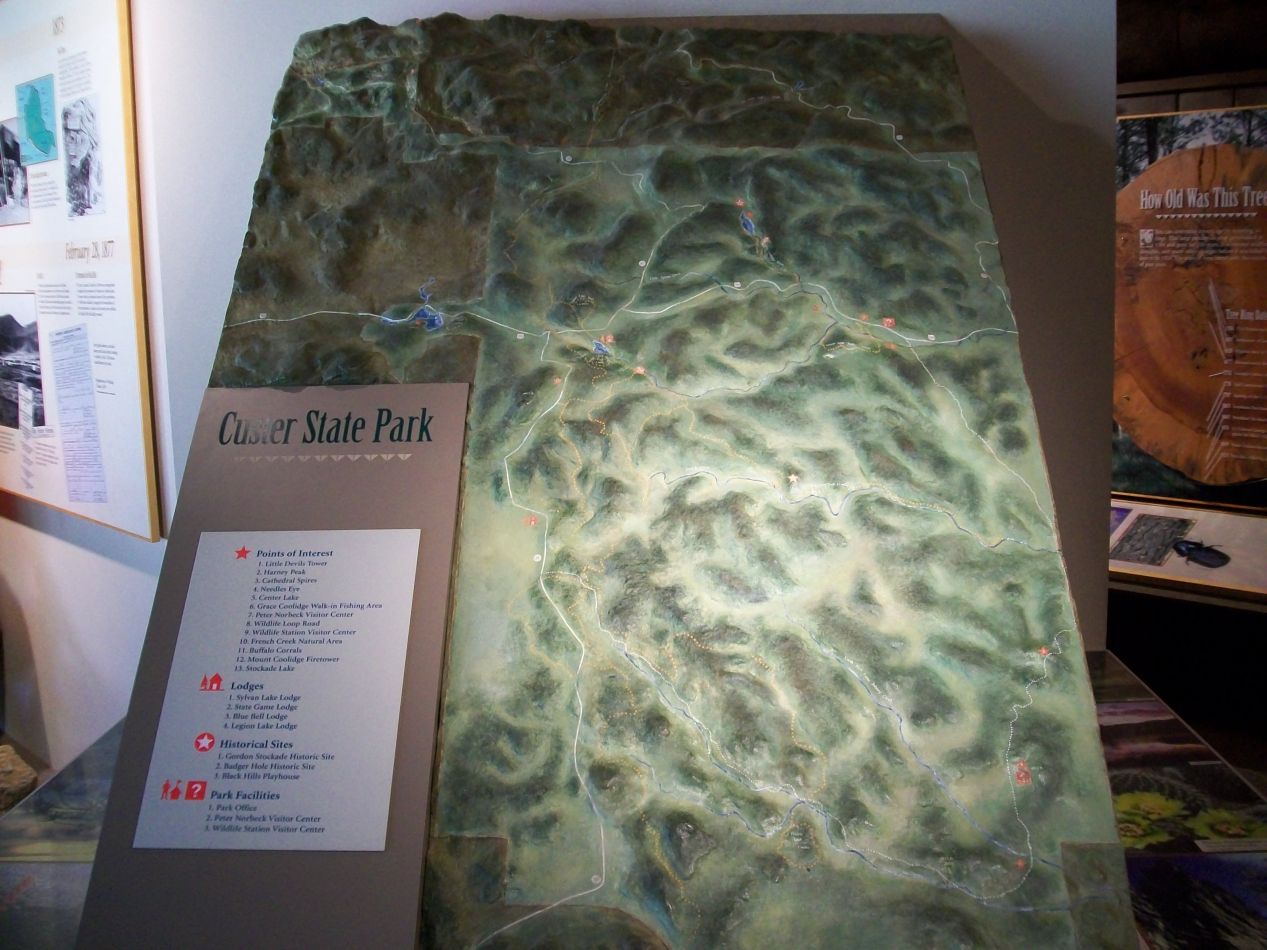


My brother wasn't arriving on his flight from Chicago until the next day and therefore we didn't visit Mount Rushmore right away, instead stopping to see some of the other attractions in the area. We first visited Custer State Park as it was en route to where we were staying in the area overnight. Custer State Park is named after the ill-fated General Custer and serves as a wildlife preserve in the Black Hills region to the southwest of Rapid City. The park is specifically known for being home to a herd of about 1500 bison (often inaccurately referred to as "buffalo", which don't actually live in North America) and there's a roundup of these creatures every year in the fall. While we didn't see any of the bison, we were treated to lovely views of the rolling green hills of the park lands on this beautiful summer day. We were situated at the northern and western edge of the Great Plains and here the terrain was starting to get rougher as it sloped up towards the mountains. It was obvious that glaciers had carved out this landscape in the recent geological past, and the generally low height to the trees hinted at the rough storms that must roll across the open plains periodically. I had never seen an environment that looked quite like this before.

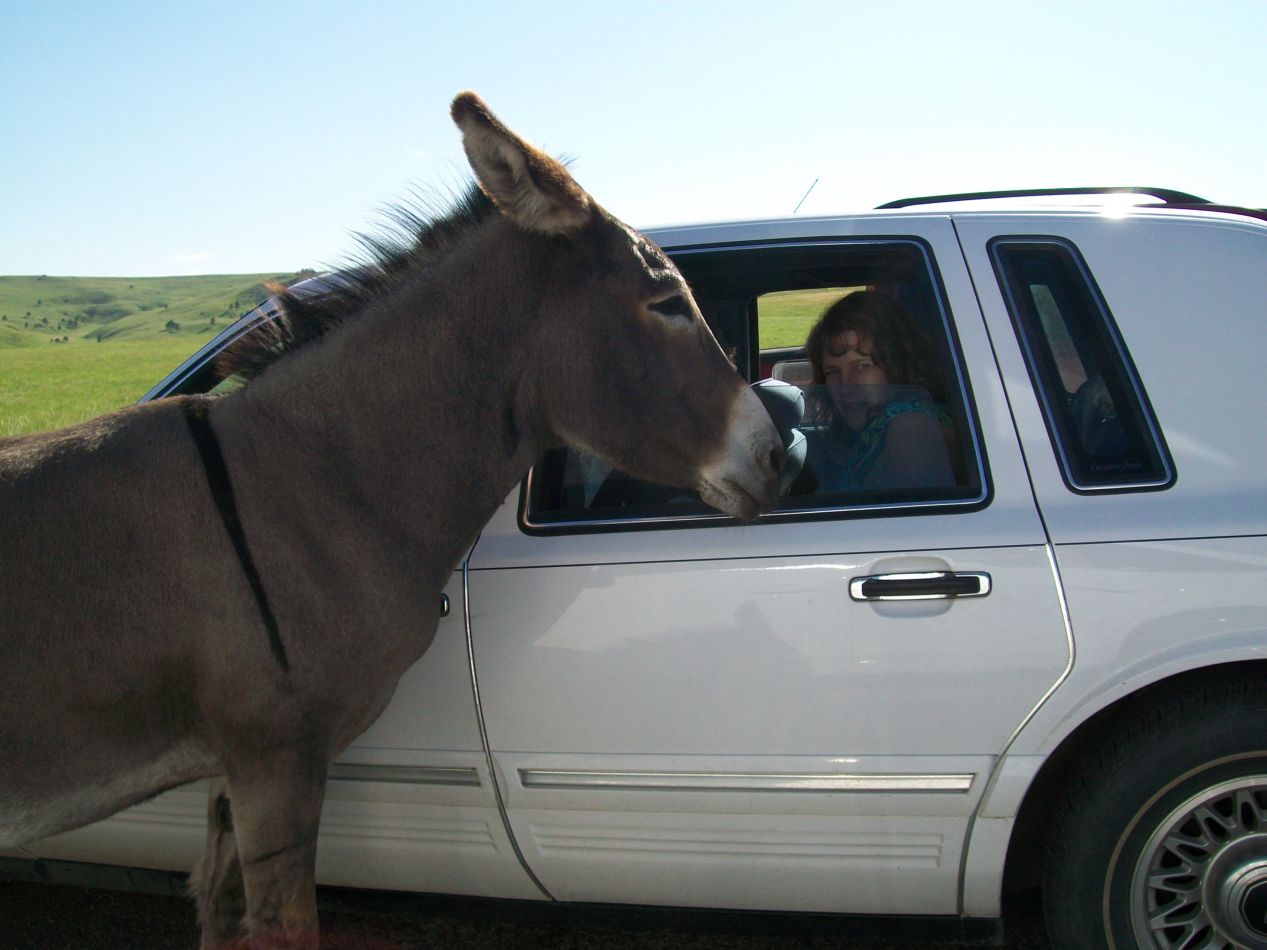


One animal that we did see in Custer State Park was these wild donkeys. Popularly called the "begging burros", the animals have become known for begging food off of passing cars. In a virtuous (or vicious) cycle, as the burros became more and more famous for their antics, more and more tourists showed up to provide them with food, and now it's impossible to drive along the main roadway in the park without running into the burros at some point. The whole thing is mostly harmless though, and the burros (which will eat almost anything) are still independent animals that live most of the year on their own, feeding off the grasses in the park. I enjoyed watching them stick their heads right in through the passing windows of cars in the hopes of getting some kind of treat. Carrots are apparently their favorite. There was even a little baby donkey tagging along with its family who looked gawky and adorable. Awwww.

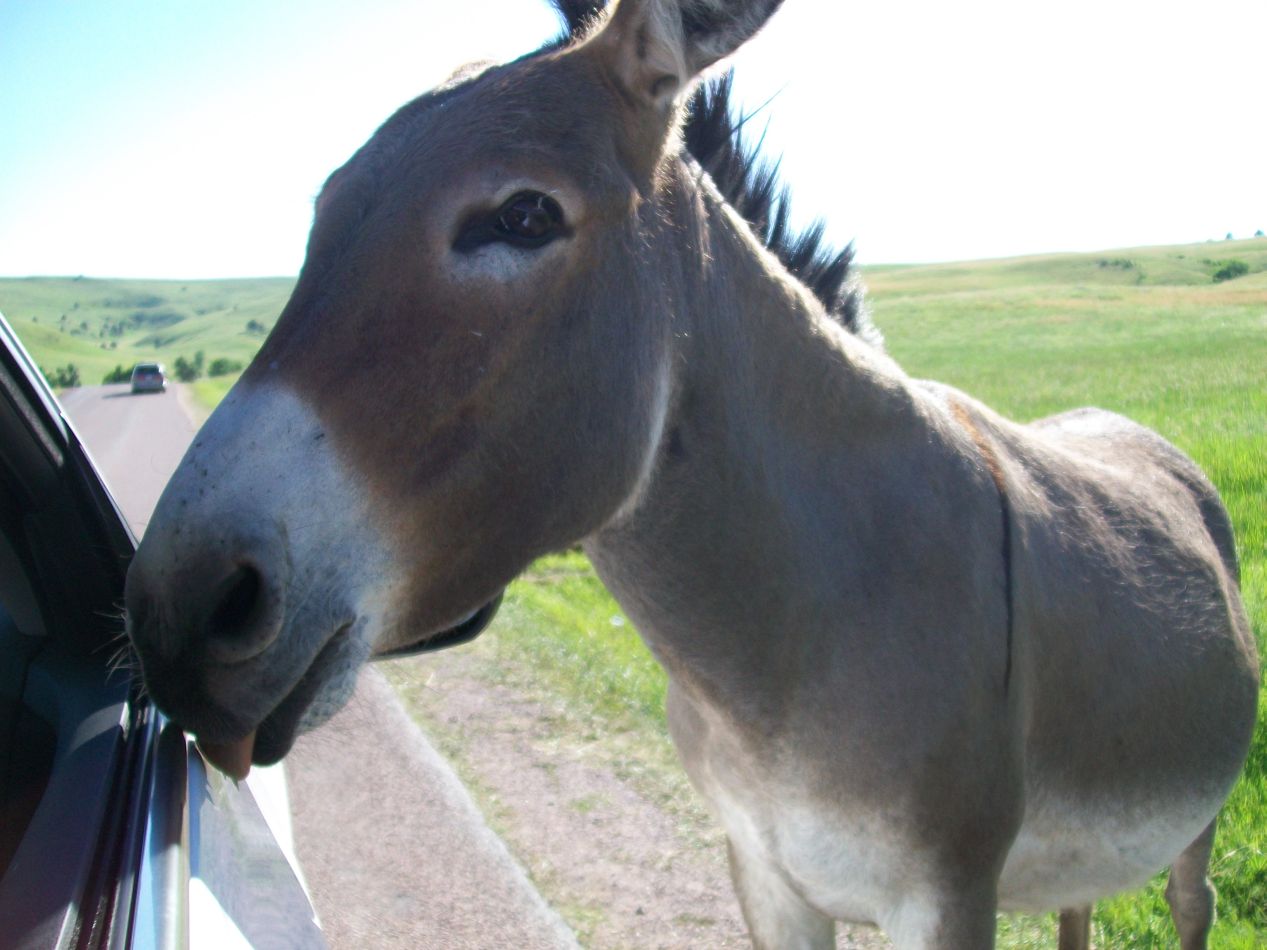


We certainly weren't spared from the attentions of the burros. One of them came right up and put his head into the passenger window of our car, looking for some tasty bits to eat. Since we didn't have any food to share, the burro quickly lost interest and moved on to better pickings elsewhere. The car behind us was getting a lot of attention, almost too much attention with four of the animals gathered around and chomping away at food donations. That family wasn't going anywhere for a while. This was a lot of fun and we wished that we had known to bring some snacks for the burros ahead of time.
By the way, there were also prarie dogs here too! We spotted a couple of them poking their heads out of the ground and scampering about. Animals that we did not see that also inhabit the park included coyotes, mountain goats, bighorn sheep, otters, cougars, and of course the aforementioned bison. Long story short, there was no shortage of wildlife to be found in the area.


We were staying for the next few days in the town of Custer, South Dakota pictured above. This was essentially a one-street town with all of the commercial establishments located along the main road and a total population of about 2000 people. Custer was one of the first non-Native American settlements to be established in the Black Hills, and spent most of its early history as a center for the gold mining industry. Today there's still a decent amount of mining and lumbering that takes place in the region, but tourism is another major form of economic activity in Custer due to the nearby presence of Mount Rushmore. This is a cheaper place to stay than Keystone, the town closest to the monument, and that made it a good choice for our family since we didn't mind a little bit more driving. We had dinner in one of the restaurants along the main street, a western-themed place with wooden decor for the walls and ceiling.




One of the strangest tourist attractions in the Black Hills area has to be this particular construction project, the Crazy Horse Memorial. This is a monument to the 19th century Lakota warrior Crazy Horse, which has been under construction since 1948 and, as of the time of this writing in 2018, still remains a long distance away from being completed. The story behind this project is almost as fantastic as the memorial itself, beginning when Henry Standing Bear, an Oglala Lakota chief, tried to have the face of Crazy Horse incorporated into the design of Mount Rushmore during the 1930s. When he received little public support for this idea, Standing Bear recruited the Polish-American scupltor Korczak Ziokowski to create a huge and separate monument to Crazy Horse by carving it out of Thunderhead Mountain, and the National Forest Service agreed to sign off on a permit allowing the project to take place. For more than seven decades now, the memorial has been under construction in the hopes of turning that initial vision into reality.

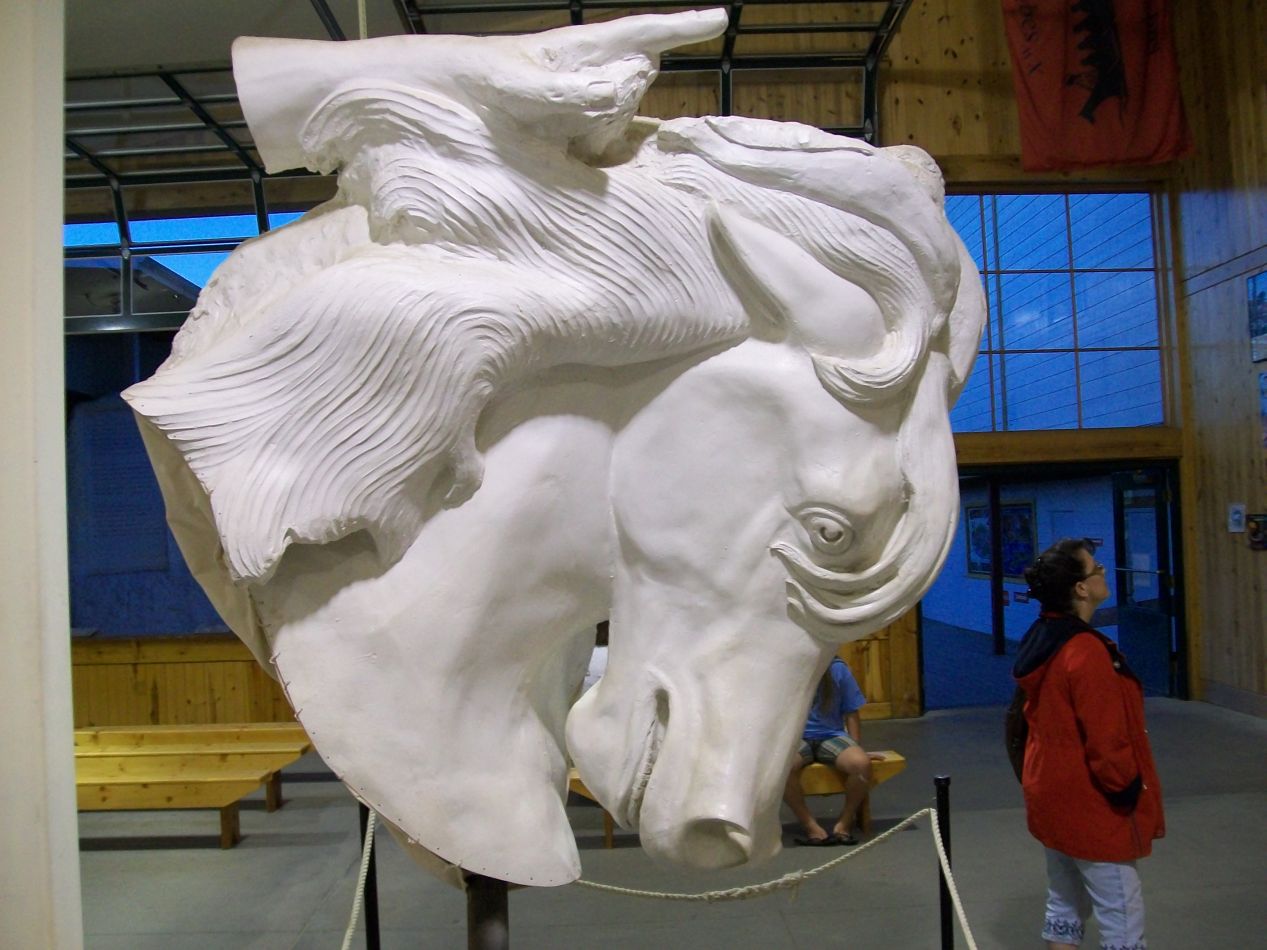


Part of the reason why it's taken so long to build the monument is due to the ludicrously large dimensions of the Crazy Horse Memorial. My dad is pictured above standing next to the 1:34 scale model of the eventual memorial, and there are more gargantuan-sized models of the figure displayed in the small museum accompanying the site. The sculpture is planned to be 640 feet (195 meters) wide and 560 feet (170 meters) tall when all is said and done. The head alone will be 90 feet / 25 meters in size, half again as large as the heads of the presidents on Mount Rushmore. It's not surprising that it's taken a long time to produce a sculpture of this size when it's literally being blasted out of a mountainside one chunk at a time.
On the other hand, the Crazy Horse Memorial could have been completed decades earlier if the Ziokowski family hadn't repeatedly turned down offers from the federal government to provide funding and manpower for the construction project. The National Park Service reportedly offered more than $10 million to help out and was turned down due to the libertarian ethos of the Ziokowskis. This is either a bold stance for freedom from government intervention or abject stupidity, take your pick. In the meantime, both Korczak Ziokowski and his wife have since passed away and their children are now overseeing the project. At the current pace, the memorial is projected to be finished sometime in the 2050s or 2060s. The only comparison that I can think of comes in the form of the medieval Gothic cathedrals which could take decades or even centuries to build, with the original founders knowing they wouldn't live long enough to see the completion. The difference here is that the Crazy Horse Memorial could be finished quickly if the owners of the project weren't determined to build it with only private sources of funding. The whole place is unique, I'll say that much.




We ate breakfast the following morning and headed back through Custer State Park again on a slightly different route. We were a bit further to the west this time, situated in the Black Hills proper instead of the edge of the Great Plains where things were more open. The landscape here was forested with evergreen trees, hardy species of plants that grew to a moderate height of perhaps 50 feet at most. There was an invasive disease of some kind that was killing off many of the trees when we visited, and sadly pockets of dead trees with brown branches were visible in a number of places. The park employees had mentioned that they were concerned about the environmental effects of this disease and didn't have an easy way to combat it. Elsewhere, we also came across more rock formations than we had seen the previous day, towers of bare stone that rose up above the enveloping forest. Some of them had particularly unusual shapes and served as modest tourist attractions:


Such as this natural rock tunnel, for example. This is known as the Needles Highway as it passes through the pictured Needles Eye Tunnel. The tunnel is a small passageway indeed and our rental car felt like it was scraping the edges of the walls as it passed through. We stopped to watch someone with a pickup truck and an ATV in the back try to get through the tunnel; from what I remember, this guy had to turn around and head back in the direction he had come from because the ATV was too tall to clear the roof of the tunnel. A very tight squeeze indeed. The rock formations here are called the Cathedral Spires and the hiking trails are supposed to be excellent in the area.

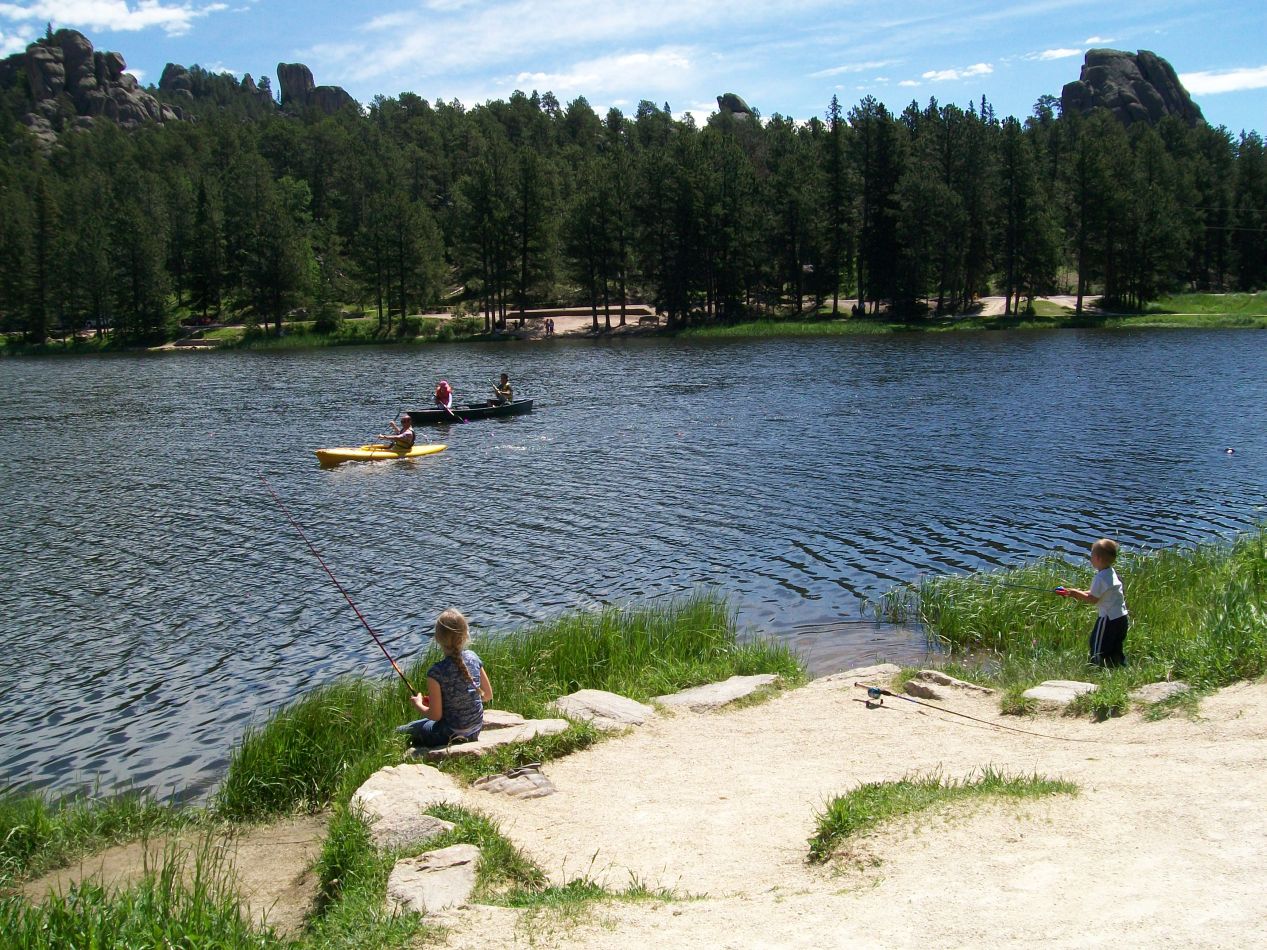


Rather than head off on a hiking expedition, we stopped for lunch at the nearby small resort known as Sylvan Lake. There's a lodge here built next to the mountain lake, which features boating, fishing, and even swimming for the brave enough. I stuck a toe into the water and it was as cold as you would expect for a lake fed by mountain streams. There were several people out on the lake in kayaks, while this little girl and her father seemed to be having success catching fish. Sylvan Lake was full of the animals, which we saw swimming about in the depths of the water. There was even a turtle that popped its head out of the water at one point. As for the lodge, it wasn't anything too fancy but it seemed like a nice play to stay and relax. The overall effect was enhanced by the weather we were enjoying, another perfect day to be outside with sunny skies and cool temperatures. Sylvan Lake was putting on its best face for us today.

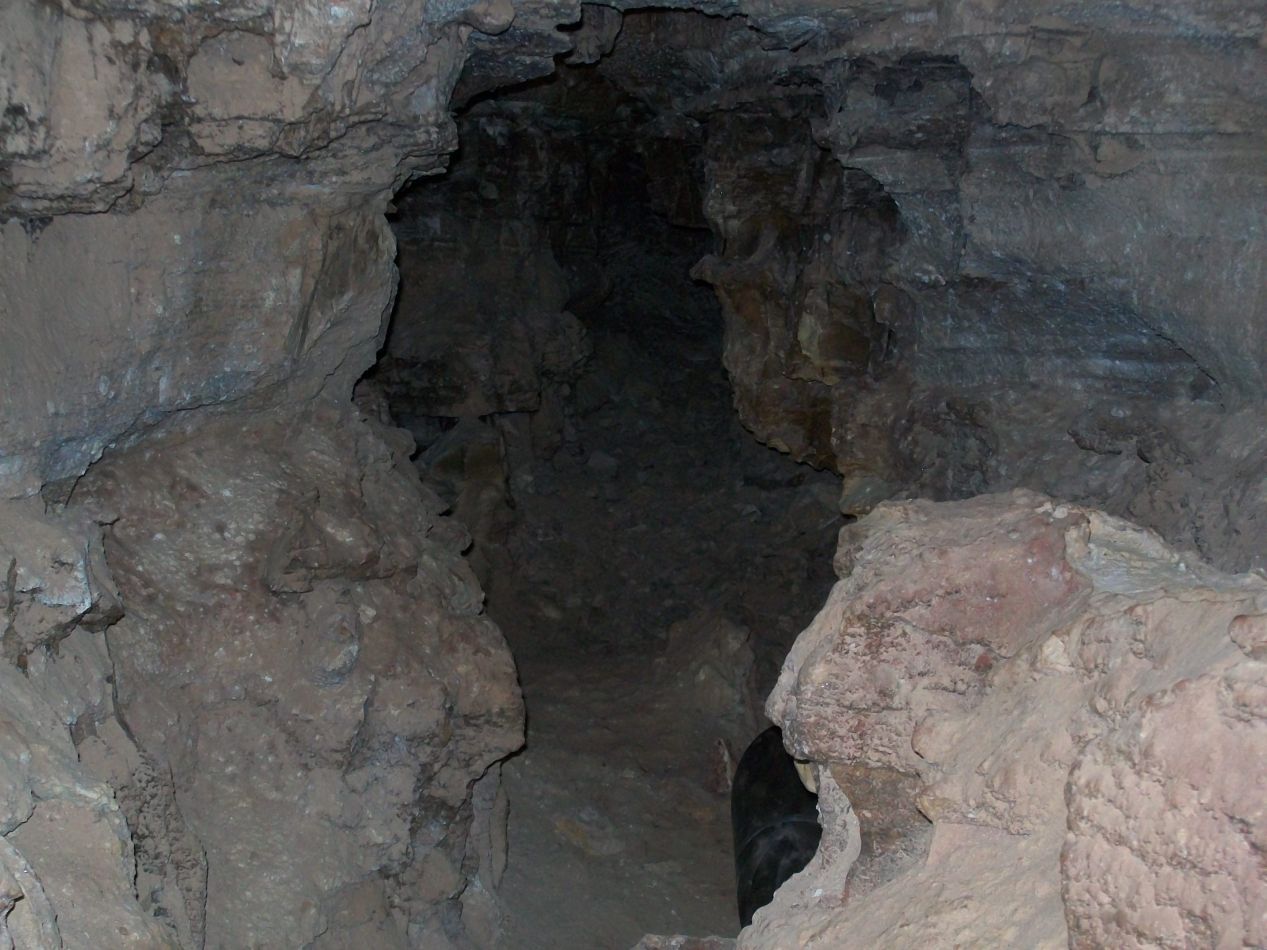


After lunch, we headed back to pick up my brother at the airport in Rapid City, then drove south to the nearby Wind Cave National Park. This is one of the oldest national parks in the country, and the first cave to be designated as such. According to the information from the tour, Wind Cave is notable for its displays of "boxwork" rock formations, a calcite projection that causes the rock to take on a honeycomb or boxlike pattern. The "Wind Cave" name comes from the way that rapid changes in atmospheric pressure outside the cave can cause wind to rush into or out of its openings. When geologic surveys of the cave revealed that there were no valuable minerals inside, Wind Cave was developed for tourism use in the late 19th century and that has obviously continued to the present day. Our tour guide kept referencing how the original exploration of the cave had been done "with just a candle... and a ball of twine." She repeated this phrase so many times, and in such an overly dramatic tone, that it became a running joke for the rest of this trip.
If there's one problem with caves, it's that they don't photograph particularly well. I was still using a cheap point-and-shoot digital camera at this point in time with a low pixel resolution, something that worked well enough in brightly lit areas but tended to struggle in dark environments. Most of the images that I have from Wind Cave are either dark and blurry or required an overly bright flash at close range. Hopefully I was able to capture some of the rock formations and the low ceilings that we passed under; my brother and I had to crouch in several places to pass through. For an example of what a professional photographer can capture in a place like this, try taking a look this image from Wind Cave.

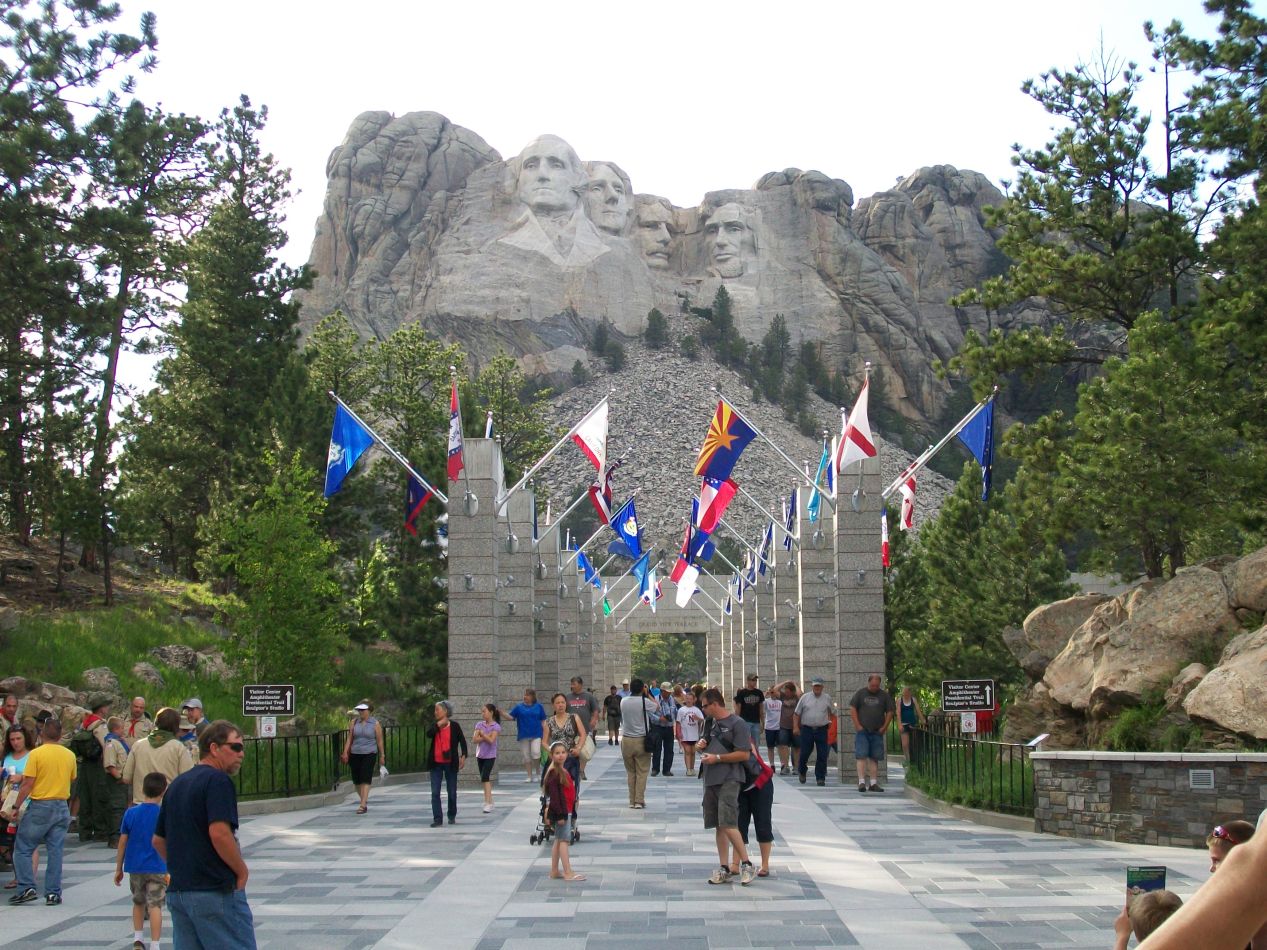


Now that we had the whole family in tow, we finally headed to see Mount Rushmore itself. This is one of the most iconic images of America, and most everyone has seen a picture of the memorial even if they haven't had a chance to visit. For those who might not be familiar with Mount Rushmore, the sculpture contains the heads of four United States presidents carved into the side of a mountain. The scultures are 60 feet / 18 meters in height and depict George Washington, Thomas Jefferson, Theodore Roosevelt, and Abraham Lincoln from left to right. Most of the work on the monument took place during the 1930s and was carried out under the direction of sculptor Gutzon Borglum, who is commemorated on the site with a small statue. An interesting detail is that the presidents were originally intended to be depicted from the waist up, and the project was limited to their heads due to lack of funding. More than two million tourists visit Mount Rushmore each year, and it's the main reason why tourism is the second largest industry in the state of South Dakota.
Everything at the site of the Mount Rushmore memorial is a tribute to American patrotism. There's an avenue with all fifty of the state flags leading up to the main viewing platform, and the gift store is full of American flags and presidential souvenirs. Even the vending machines here had a big photograph of the four presidential heads on the front instead of the normal "Coca Cola" branding. While the straight-on views of Mount Rushmore were pretty much identical to what can be seen in pictures, being at the memorial allows you to see it from the side and some other unorthodox positions. One of the most interesting sights of the mountain was turning around a bend in the road while we were driving and suddenly seeing these huge heads carved out of the rocks above. That was unexpected and a genuine pleasure to see. I was also surprised to find an amphitheatre directly below the viewing platform near the foot of the mountain, where we found out that there would be a live stage show later that evening. We decided that we would come back after dinner to see it.

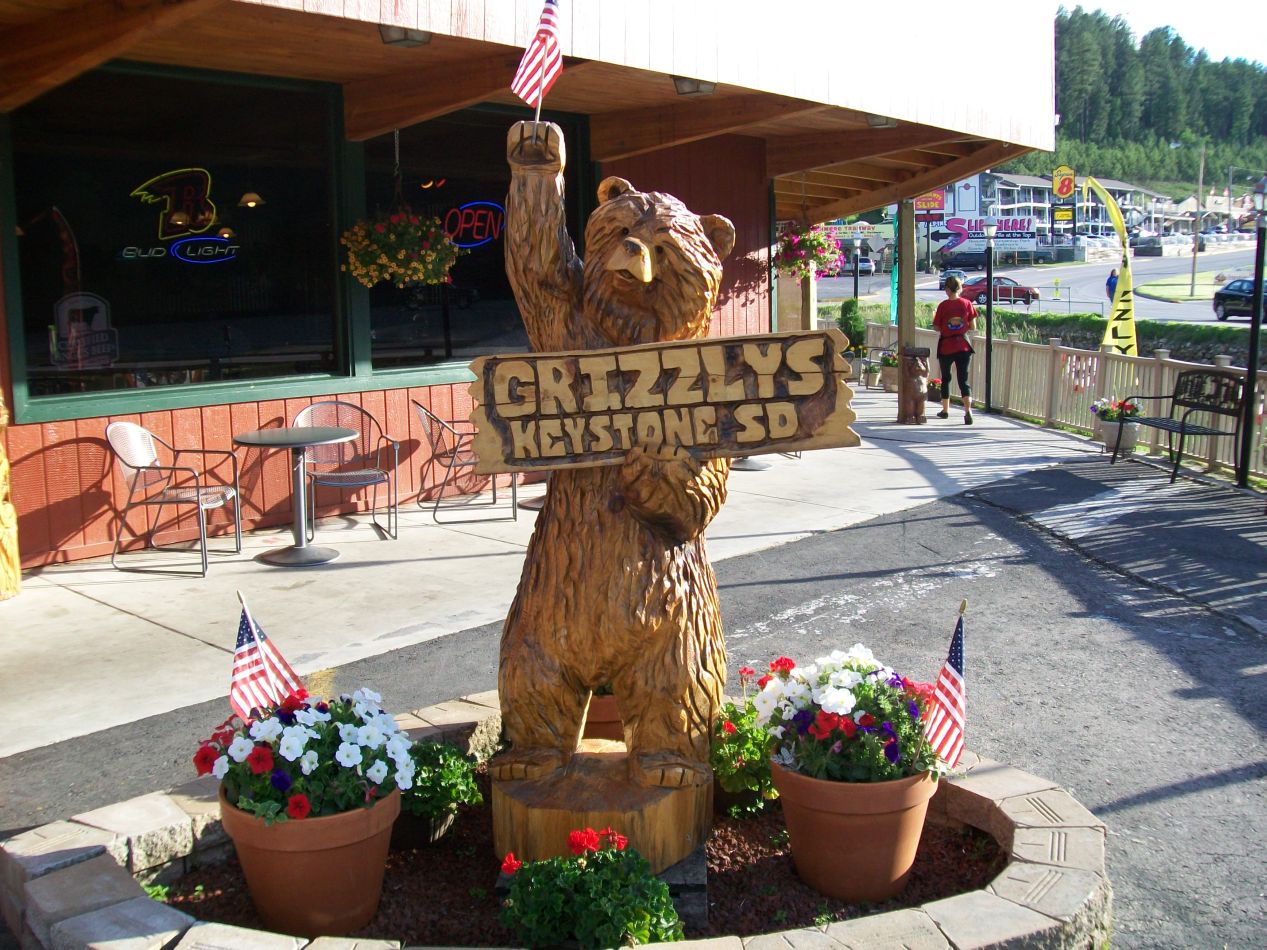


We ate dinner in the nearby town of Keystone, the town closest to Mount Rushmore at only a few miles of distance. This is ground zero for the tourist trade and Keystone is full of tacky Rushmore-themed souvenir stands and cheap hotels. After seeing the place, we were glad that we had decided to stay a little bit further away in the town of Custer. There was no shortage of presidential memorabilia or buffet meals to be found in Keystone. It wasn't all bad though, with a small museum dedicated to sculptor Gutzon Borglum that was closed for the evening, and a chainsaw art store with some wild carvings. I particularly enjoyed the 15 foot tall carving of an eagle clutching a fish on top of a winding tree branch, which was selling for a cool $15,000 (in 2011 dollars). Who would buy something like that?! Who would even have the space for it?

There were also a lot of shirts on sale that looked like this. South Dakota is a conservative state and some of the stores were quite happy to overdose on the patriotism and promote a form of jingoistic nationalism. I don't want this travel blog to slip into the realm of politics, so I'll simply mention that highly visible support for gun ownership is only one of many forms of American patriotism, not the sole way to display support for one's country.


These were some of the scenes from the evening show at Mount Rushmore, once again taken with my cheap camera that struggled in poor lighting. The theme of the show was based on - what else? - American patrotism, with a brief discussion of the history of Mount Rushmore and the presidents it displays sandwiched around performances of various American songs. They played the national anthem, God Bless America, and more songs in that same vein. At one point, the park service asked any veterans in the audience to come down to the stage, which received the largest standing ovation of the night. Overall, it was a decent but not great show, with a little too much in the way of showy "rally around the flag" patriotism for my tastes.
We had spent these first two days exploring the Black Hills region to the immediate southwest of Rapid City. Over the next few days, we would range further afield and visit Badlands National Park off to the east, before turning in the opposite direction and driving into Wyoming en route past the natural monument known as Devil's Tower. Our trip through the western Rockies was only just getting underway.



